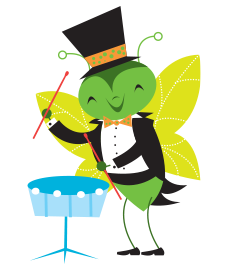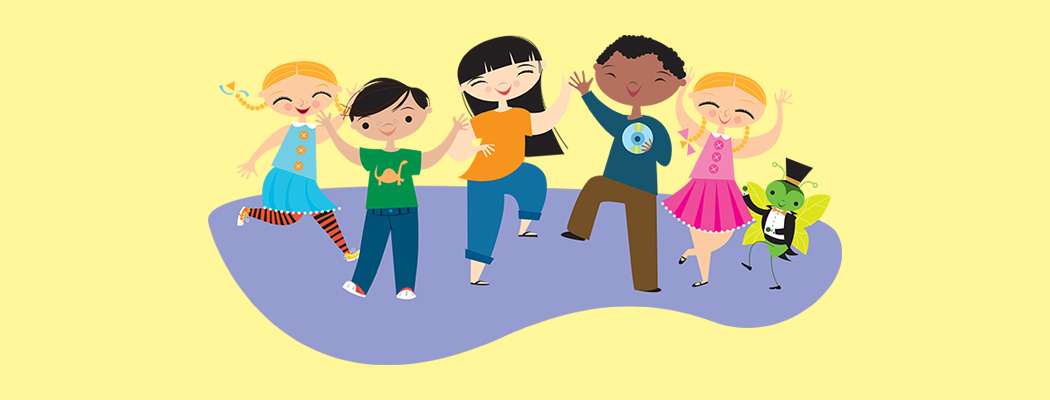Fun and imagination for a Spirit of Play
What is this world of the young beginner? It is fun, fantasy, and exploration. Seriousness? Teacher-driven rules? Tight control? These close down a young learner’s intrinsic interest. Playfulness? Creativity? Adventure? These drive the youngster’s learning. And the multi-sensory world of music makes a perfect context for such a playful adventure. My First Piano Adventure takes the young student into a musical “playground” where we explore, we hear, we look, we learn. To fully engage the child, the course presents visual, auditory, and kinesthetic (feel/touch) activities through a spirit of play, including playmates — the “friends at the piano” of My First Piano Adventure. These five musical friends, along with Tap the music firefly, pose a new adventure with each piece: swimming with a whale, climbing to a tree house, riding a birthday train! Listen to the CD track, featuring young children’s voices, and enjoy a large movement activity. Chat about the delightful artwork to open communication with the student and bring the musical page alive. Next, make it tactile at the piano. Feel the keys and together, sing finger numbers, letter names, and words. Laugh, imagine, and have musical fun with the student for a flying start.
“Have you heard a youngster say, “Again! Again!” taking delight with each repetition? These are wonderful moments”
Activity based learning for Focused Learning
We’ve all heard of the young child’s short attention span. While this is a valid characteristic to which we adapt, let’s be equally impressed with the young child’s focus when emotionally engaged. Have you heard a youngster say, “Again! Again!” taking delight with each repetition? These are wonderful moments. So the capacity for sustained attention is there, even for the young child. The key is activity-based learning. A basic “rule of thumb” is that the length of an activity may roughly correspond to the child’s age (5 minutes for a 5-year-old). That being said, a teacher’s observations “in the moment” should always drive the rhythm of the lesson. If attention wanes, implement change. Hop off the bench, move to the Writing Table, go on a crotchet hunt, play rhythm instruments in the Music Circle, go back to the piano! Keep your lesson plan varied and be flexible with your student. Celebrate student favourites and visit them from week to week to glean all their capacity for musical development. Well-paced activities combined with a “spirit of play” will create a lesson full of excitement and focused attention.

Creative metaphors for First Technique
Noodle fingers… small hands… no coordination… maybe we should wait until the child is older? This fallacy is remedied by recognizing that a child will never “grow” a pianistic hand. A pianistic hand is developed through guidance and practice. For the young beginner, we can adapt our teaching routine and use child-centered technique activities that smoothly guide development of the small hand. For instance, the chant Stone on the Mountain (Lesson Book pp. 12-13) introduces essential aspects of technique that include a round hand shape, arm weight, (free-fall drop) and rising wrist motion. A few pages later, Cookie Dough (p. 17) addresses a firm fingertip—pressing imaginary chocolate chips into the dough. This prepares the student to play the white keys with a braced finger 3 for L.H./R.H. Donuts and the all-time student favorite Twinkle, Twinkle Little Star (pp. 18-21). In Mitsy’s Cat Back (p. 25), an upward/forward wrist motion that drives the “bridge” over the fingers is practiced with an appealing, jazzy song. This wrist motion then progresses into an expressive “rainbow” gesture that carries the hand gracefully across the keys. The overall progression of technique throughout the book models the pianist’s hand structure and alignment of finger, wrist, and arm.
Movement and Singing for Rhythm and Pitch
While it is exciting to see the child develop good technique, it is equally exciting to observe development of rhythm and pitch perception. These skills progress most effectively with early-age exposure. My First Piano Adventure puts special focus on this aspect of brain development with the audio CD that encourages singing and rhythmic body movement. For rhythm, emphasize feeling a steady beat in the body. From the first song, Roll Call, which introduces the “friends at the piano,” we can tap, march, and play rhythm instruments. For the popular Monster Bus Driver, children “honk the black keys” and “beep back” rhythm patterns. Students soon play the repeating and now notated rhythm pattern of Monsieur Mouse, and “squeak” longer, varied patterns in Mouse Rhythms (Writing Book pp. 32-33). The audio CD recordings emphasize singing, with childrens’ voices showcasing a variety of tempi, moods, and keys. As the book continues, students are challenged to play a steady rhythm pattern against the busy melody of Boa Constrictor (Writing Book pp. 50-51). Later they play and chant the Music Alphabet in rhythm to If You’re Happy.

Summary
The joy and reward of teaching young students more than offsets the challenges. And the challenges are readily addressed with an effective curriculum and a cheerful, playful environment. My First Piano Adventure provides the curriculum. The best teaching advice is—keep it fun! The child’s life at this age revolves around fun and for good reason. Fun motivates play, and play is the child’s “magic formula” for learning. Enjoy teaching My First Piano Adventure!
